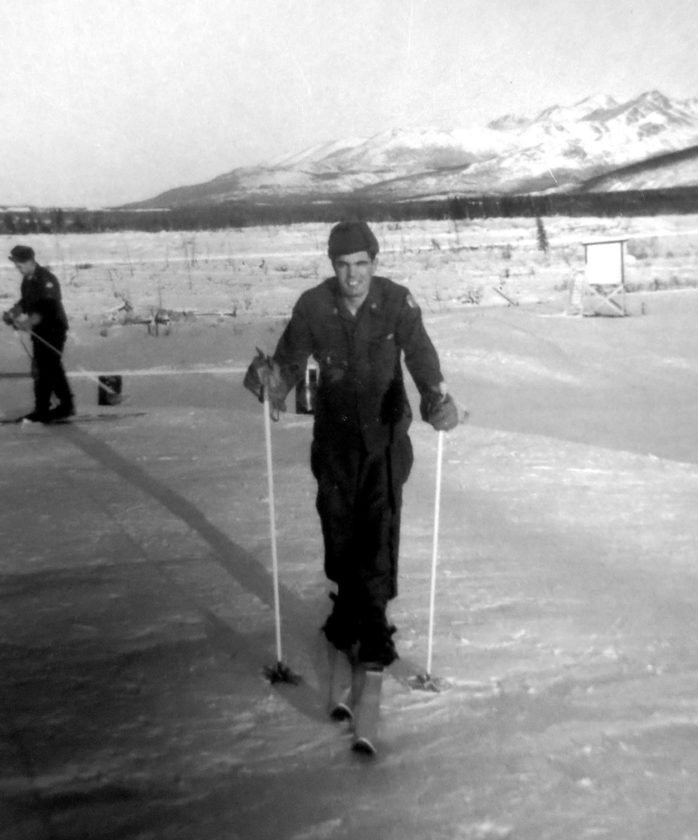Jumping from Niagara to Alaska
Former ski jumper Chartier to give museum talk about experiences
- FORMER SKI JUMPER Sam Chartier of Niagara, Wis., alongside the new ski jumping exhibit at the Niagara Historical Museum. (Theresa Proudfit/Daily News photo)
- Sam Chartier found his ski-jumping skills to be beneficial while serving in the U.S. Army in Alaska during the 1950s. (Submitted photo)

FORMER SKI JUMPER Sam Chartier of Niagara, Wis., alongside the new ski jumping exhibit at the Niagara Historical Museum. (Theresa Proudfit/Daily News photo)
NIAGARA, Wis. — Sam Chartier remembers the first skis he used to jump off the hill in Niagara at age 12.
They were shaped from wood and strapped to his feet with inner tubes from old car tires, he said.
“I had been jumping off the small jumps with rubbers on my feet when my brother came home from the Second World War and bought me my first pair of jumping skis,” Chartier said.
One of The Niagara Area Historical Society’s new exhibits this season centers on the community’s ski tradition. Ski jumping in Niagara began in 1937 and the sport was relevant in the community into the ’70s.
The new ski exhibit includes historic photos and information about the hills, wooden skis for downhill and jumping, poles, a toboggan and other paraphernalia.

Sam Chartier found his ski-jumping skills to be beneficial while serving in the U.S. Army in Alaska during the 1950s. (Submitted photo)
To highlight opening the new exhibits, the museum plans to have a series of storytelling programs, with the first to feature Chartier from 1 to 4 p.m. Saturday, March 24.
Like many area youth at the time, Chartier spent his spare time jumping at Wodenka Hill in Niagara, under the guidance of Herb Peterson, who coached many young ski jumpers in the area over several years.
“Herb Peterson was the guy that started ski jumping in Niagara,” he said.
Spending his childhood skiing with guys like Gene Steeno, Billy Lantagne, Billy Harwath, Dicky Peterson, Mertin Brault and Ronald Brault, Chartier considered himself a decent jumper, occasionally placing a second or third in tournaments.
He remembers the year he won a tournament in Appleton, Wis. — one that he almost missed.
“I lived in Frenchtown at the time. We were waiting to be picked up for the tournament at the Kimlark Inn and they took off without us. We were little kids, standing out there. I had tears in my eyes,” he said.
Peterson, their regular driver, had to work that day and a substitute driver was responsible for leaving the boys behind. Peterson told the boys to call Edwin Aderman, who had just returned from the U.S. Army.
“So Edwin Aderman came and scooped us up and we went down to Appleton. I took first place in my class that day,” Chartier said.
The day famous ski jumpers Torger Tokle and Art Devlin came to Niagara was another memorable one for Chartier. The athletes showed up early in the week for practice jumping and used the Niagara jump while the Pine Mountain hill was being prepared for the 1942 tournament.
Teachers and students took the day off to watch the ski jumping. “They emptied the entire school out,” said Chartier.
Tokle and Devlin were such experienced jumpers that “they had to pull back or they would of jumped over the entire landing area,” he said.
Knowing how to ski came in handy when Chartier was drafted into the U.S. Army and sent to Alaska at the end of the Korean War amid Cold War fears about a possible Russian invasion.
Chartier had been in the mountains with a couple of sergeants as a New York film crew was shooting a training film, “Fighting a War in Alaska.”
They were looking for experienced skiers after soldiers brought in from Maine couldn’t stand on their skis, blaming the different snow and harsh Alaskan conditions.
When asked by his sergeant, Chartier said, “I’m not a champion, but I can ski.” He quickly joined the cast.
“I was only a corporal, but I was playing a lieutenant in the film. I was 19 years old and I was showing off,” he said. The camera crew wondered how Chartier would navigate around a large hole in the hill. “I’ll jump it,” Chartier replied.
After “opening his mouth,” Chartier said he “prayed to God in heaven that he was good at jumping, too.” He landed the jump with ease but ended up sliding into the woods. No one was eager to trudge through the snow to help the teen, but he managed to jump to his feet, giving a shout out to Iron Mountain and Niagara snow for his accomplishments.
“Ski jumping was good to me,” he said.
Museum Director Karen Klenke said the society also is working toward a second storytelling event for the opening of the Redette’s Drill Squad exhibit this summer. The Redettes represented Niagara from 1963 to 1982 bringing home many honors as they marched for their home town. The Redette exhibit contains flags, uniforms, trophies, photos and other memorabilia.
Also in early planning stages is a hands-on exploring program for children. “It will be small, but mighty,” she said.
For more information on the event, call Klenke at 715-251-4557.







